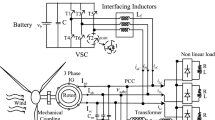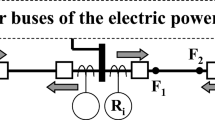Abstract
This paper presents a procedure to reduce system loss using Static Synchronous Compensator (STATCOM) devices in a power system network (PSN). The bus power sensitivity factors (BSF) represented by the change in system loss to the change in power injections (CPI) for all the buses of a PSN are determined to identify the suitable location of STATCOM devices. Initially, a load flow (LF) analysis is carried out with the baseload to obtain the BSFs. Then, the buses with significant values of BSFs are considered to introduce STATCOM devices. Based on the real and reactive power sensitivity factors (SFs) of the buses with STATCOM devices, Particle Swarm Optimization (PSO) technique is used to obtain the necessary change in real and reactive power injection (RRPI) to reduce the system loss. Then with the modified schedule power injections, the LF analysis with STATCOM (LFSTATCOM) is conducted to determine the voltage magnitude and phase angle of the STATCOM device. The proposed algorithm is implemented on the IEEE 118 bus to verify its effectiveness and MATLAB software is used to develop the program to implement this method. The result shows that the implementation of STATCOM devices at the selected sensitive buses of the system could reduce the system loss to 2.2691 p.u. from 3.085 p.u. by regulating the power injections at the selected buses with STATCOM devices. In addition to this, it also improves the bus voltage profile of the IEEE 118 bus system. Further, to show the economic benefit of installing STATCOM devices at the selected buses of the PSN the cost–benefit analysis (CBA) has been carried out based on the installation cost (IC) of STATCOM devices and the cost saving results from the reduction of system loss.



Similar content being viewed by others
Abbreviations
- \(k,m\) :
-
Bus numbers
- \(n\) :
-
Total no of buses in the system
- \(P_{k} + jQ_{k}\) :
-
Complex power injection at kth bus
- \(V_{k} \angle \delta_{k}\) :
-
Voltage at kth bus in polar form
- \(G_{km} + jB_{km}\) :
-
Elements of bus admittance (Ybus) matrix
- \(P_{L}\) :
-
System loss
- \(\Delta P_{k} + j\Delta Q_{k}\) :
-
Change in complex power injection at kth bus
- \(P_{sh}^{sch} + jQ_{sh}^{sch}\) :
-
Schedule value of complex power contribution with STATCOM
- \(SF_{P}\) :
-
SF due to change in real power injection
- \(SF_{Q}\) :
-
SF due to change in reactive power injection
- \(V_{sh} \angle \delta_{sh}\) :
-
Voltage output of STATCOM in polar form
- \(g_{sh} + jb_{sh}\) :
-
Elements of admittance of converter transformer in complex form
References
P. Yan, A. Sekar, Steady-state analysis of power system having multiple FACTS devices using line-flow-based equations. IEE Proc. Gener. Transm. Distrib. 152(1), 31–39 (2005)
B. Gorazd, R. Mihalic, Considering controllable devices using standard load flow programs–SSSC example. Int. J. Electr. Power Energy Syst. 99, 355–362 (2018)
B. Gorazd, M. Pantos, R. Mihalic, Newtonian steady state modeling of FACTS devices using unaltered power-flow routines. IEEE Trans. Power Syst. 34(2), 1216–1226 (2018)
V. Anton, R. Mihalic, Universal method for the modeling of the 2nd generation FACTS devices in Newton-Raphson power flow. Int. J. Electr. Power Energy Syst. 33(10), 1631–1637 (2011)
H.A. Perez, E. Acha, C.R. Fuerte-Esquivel, Advanced SVC models for Newton-Raphson load flow and Newton optimal power flow studies. IEEE Trans. Power Syst. 15(1), 129–136 (2000)
X. Ying, Y.H. Song, Y.Z. Sun, Power flow control approach to power systems with embedded FACTS devices. IEEE Trans. Power Syst. 17(4), 943–950 (2002)
B. Suman, B. Das, N. Kumar, An indirect UPFC model to enhance reusability of Newton power-flow codes. IEEE Trans. Power Delivery 23(4), 2079–2088 (2008)
B. Suman, B. Das, N. Kumar, An advanced IPFC model to reuse Newton power flow codes. IEEE Trans. Power Syst. 24(2), 525–532 (2009)
S.N. Singh, A.K. David, Optimal location of FACTS devices for congestion management. ELSEVIER Electr. Power Syst. Res 58(2), 71–79 (2001)
S. N. Singh, and A. K. David, Placement of FACTS device in open power market. in Proc. 2000 IEEE Power System Control, Operation and Management (APSCOM-2000), Oct. 30–Nov. 1, vol. 1, (2000), pp. 173–177.
D. Hazarika, B. Das, Use of transmission line having SPFC for alleviation of line over load of transmission line of an interconnected power system. Int. J. Electr. Power Energy Syst. 63, 722–729 (2014)
N. Li, Xu. Yan, H. Chen, FACTS-based power flow control in interconnected power system. IEEE Trans. Power Syst. 15(1), 257–262 (2000)
S. Yuhui, R.C. Eberhart, "Empirical study of particle swarm optimization." Proceedings of the 1999 congress on evolutionary computation-CEC99 (Cat. No. 99TH8406), vol. 3, (1999), pp. 1945–1950.
A. Mohammad, Optimal power flow using particle swarm optimization. Int. J. Electr. Power Energy Syst. 24(7), 563–571 (2002)
M. Saravanan, S.M.R. Slochanal, P. Venkatesh, J.P.S. Abraham, Application of particle swarm optimization technique for optimal location of FACTS devices considering cost of installation and system loadability. Electric Power Syst. Res. 77(3–4), 276–283 (2007)
H. Klaus, D. O’Leary. FACTS-flexible alternating current transmission systems: for cost effective and reliable transmission of electrical energy. Siemens-World Bank document–Final Draft Report, Erlangen 46, (2004)
P.S. Singh, N. Malik, Optimal integration of multi-type DG in RDS based on novel voltage stability index with future load growth. Evol. Syst. 12(4), 981–985 (2020)
O.I. Elgerd. Electric energy systems theory an introduction. TATA McGRAW-HILL Publishing Company LTD Indian Edition July 2017
http://www.ee.washington.edu/research/pstca/pf118/pg_tca118bus.htm
Funding
The authors certify that this research did not receive any specific grant from funding agencies in the public, commercial or not-for-profit sectors.
Author information
Authors and Affiliations
Corresponding author
Ethics declarations
Conflict of interest
The authors declare that there is no conflict of interest.
Additional information
Publisher's Note
Springer Nature remains neutral with regard to jurisdictional claims in published maps and institutional affiliations.
Rights and permissions
About this article
Cite this article
Dey, S., Deka, N. & Hazarika, D. Power System Planning for Reduction in System losses using STATCOM and PSO Technique. J. Inst. Eng. India Ser. B 103, 1269–1281 (2022). https://doi.org/10.1007/s40031-022-00715-9
Received:
Accepted:
Published:
Issue Date:
DOI: https://doi.org/10.1007/s40031-022-00715-9




